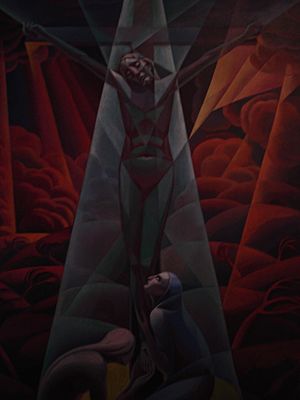Gerardo Dottori facts for kids
Gerardo Dottori (born November 11, 1884 – died June 13, 1977) was an Italian Futurist painter. He was one of the artists who signed the Futurist Manifesto of Aeropainting in 1929. Dottori spent most of his life in the city of Perugia. He lived in Milan for six months as a student and in Rome from 1926 to 1939.
Dottori mostly painted landscapes and scenes of Umbria, often as if seen from high up in the sky. Some of his most famous works are Umbrian Spring and Fire in the City, both painted in the early 1920s. Fire in the City can now be seen at the Museo civico di Palazzo della Penna in Perugia, along with many of his other paintings. His art was even part of the art competitions at the 1932 Summer Olympics and the 1936 Summer Olympics.
Life of an Artist
Gerardo Dottori was born in Perugia into a family that wasn't rich. His mother passed away when he was eight years old. As a young man, he was accepted into the Academy of Fine Arts in Perugia, which is an art school. At the same time, he worked for a shop that sold old art.
In 1906, he worked as a decorator in Milan. This allowed him to visit many museums and art exhibitions. He went back to studying art in 1908 and met artists in Florence who were trying new and exciting things with their art. In 1910, he started working with an art magazine called Defense dell'Arte.
Joining the Futurists
In 1911, Dottori moved to Rome where he met Giacomo Balla, another famous artist. Dottori soon became a follower of Futurism, an art movement focused on speed, technology, and the future. In 1912, he joined the first Futurist group in the Umbria region.
During World War I in 1915, Dottori fought in the war. At the same time, he wrote a type of poetry called Parole in libertà ("Words in freedom"), which he published under the name G. Voglio.
In 1920, he started his own Futurist magazine called Griffa!. That same year, he had his first art exhibition in Rome. In 1924, he attended a big meeting called the Futurist Congress. By then, he was quite well-known and shared his ideas about "Rural Futurism." In the same year, he showed his art at the famous Venice Biennale, becoming the first Futurist artist to do so. Throughout his life, he participated in ten Biennales.
From 1926 to 1939, Dottori lived in Rome and wrote for various art magazines. He showed his art in many Futurist exhibitions, including a solo show in 1931.
Aeropainting and Sacred Art
Dottori's most important contribution to Futurism was Aeropainting. This style of painting showed things as if seen from an airplane, often from a high viewpoint. He was one of the artists who signed the 1929 Aeropainting Manifesto. This manifesto was a public statement of ideas about Aeropainting. Other famous artists like Benedetta Cappa, Fortunato Depero, Fillìa, Filippo Tommaso Marinetti, and Enrico Prampolini also signed it.
In 1932, Dottori was one of the first Futurists to paint religious subjects. This happened after the Futurist Manifesto of Sacred Art was signed in 1931 by Marinetti and Fillìa. Futurists started painting religious art after the Lateran Treaty was signed in 1929 between the Vatican and Fascist Italy.
In 1939, Dottori became a professor of painting in Perugia and taught there until 1947. In 1941, he wrote the Manifesto of Umbrian Aeropainting. In this, he explained that his Futurist art was mainly about showing mystical landscapes.
Dottori also created many large wall paintings, called murals. Some of these include works at the Altro Mondo in Perugia and the hydroport in Ostia. Futurists liked mural painting, and they even wrote a Manifesto of Mural Plasticism.
After World War II, there was a quiet period for Marinetti's Futurism. However, Dottori continued to show his art in the 1950s and 1960s. In 1989, a special exhibition of Dottori's work was held at the Gallery San Carlo.
His painting Crocifissione (1927), which shows the crucifixion of Christ in a Futurist style, is now kept in the Vatican Museum.
See also
 In Spanish: Gerardo Dottori para niños
In Spanish: Gerardo Dottori para niños


